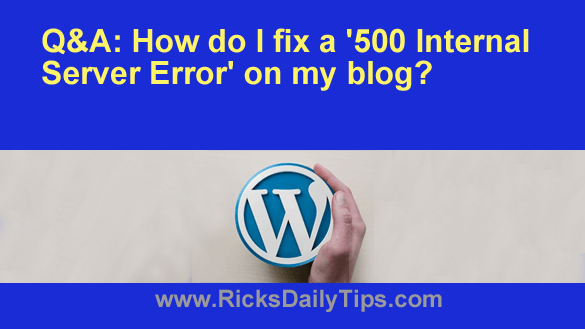 Question from Bobby: I need some fast help, Rick. I updated a plugin on my WordPress blog and now none of the pages will load!
Question from Bobby: I need some fast help, Rick. I updated a plugin on my WordPress blog and now none of the pages will load!
When I visit the site all I get is a blank page with the words “500 Internal Server Error” on it. I can’t even log in to the dashboard to disable the bad plugin!
Can you tell me how to fix this error and get my blog back up? It’s been down for two whole days already!
Please help me ASAP if you don’t mind!!
Rick’s answer: Bobby, buggy or incompatible plugin updates are among the top reasons for WordPress blogs going belly up.
Luckily, even though “white pages of death” caused by plugin issues are frightening, they are usually very easy to fix.
What you need to do is delete the plugin from the /wp-content/plugins/ directory on your blog’s web server.
Just use any “FTP” program or the “File Manager” utility in your web host’s Control Panel to navigate to the /plugins/ directory and delete the offending plugin’s sub-directory.
Important: DO NOT delete the entire /plugins/ directory! Just delete the sub-directory containing the plugin that’s causing the error.
For example, if the plugin causing the problem was named Awesome Plugin you would delete the /awesome-plugin/ sub-directory.
Once you’ve deleted the bad plugin, test your blog to see if it loads correctly. If so, you can try re-installing the plugin that caused the error.
Sometimes these things are simply caused by glitches with the update process. If that’s the case in this instance reinstalling the plugin from scratch should have your blog back up and running with that plugin in no time.
However, if the same plugin causes the error again, simply delete it once again and search for another plugin that performs the same function by opening the WordPress Dashboard and clicking Plugins>Add New.
By the way, issues like this are one of the many reasons why I recommend always having a current backup of your entire blog on hand. And when I say “entire blog”, I mean everything – the WordPress core files, the database, the themes and all the plugins.
As it was with this case, issues caused by bad plugins can usually be easily resolved by simply deleting the plugin via FTP. But unfortunately, there are times when that doesn’t work. In those rare instances it’s often faster and easier to simply reinstall the blog from a backup than to troubleshoot the issue.
There are a number of great WordPress backup options to choose from but I use and recommend the amazing VaultPress remote backup service from our friends over at Automattic.
Update from Bobby: A thousand thanks, Rick! I used FileZilla to delete the bad plugin and now everything works fine. I won’t even bother replacing it because all it does is display a fancy tag cloud, which I don’t really need. Thanks again!
Bonus tip: This post explains how to prevent your WordPress blog from getting hacked.